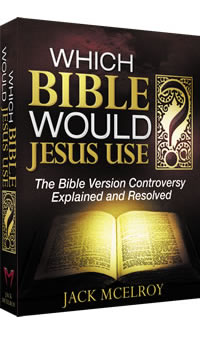Does Mark 16 Have 20 Verses... Or 8?
By David W. Daniels
We were so excited! My wife Deborah and I were going to hear my Bible college Greek professor preach on the Resurrection at a local church. He said Mark 16 would be his only text. I was sure of what he would say. But I was so wrong.
Instead, this text critic told us about some "very significant omissions" in "the oldest manuscript," Codex Sinaiticus. He claimed that, originally, Mark 16 only had 8 verses. He guessed that the last 12 verses were added later, because someone simply misunderstood the abrupt ending to the Gospel.
In verse 8, the King James and most Bibles say the women left the tomb afraid —which seems a strange way to end the Gospel. But he claimed "afraid" could also mean "in awe." So the women left the tomb "in awe" —end of story. He wouldn`t read verses 9-20, because, they weren`t in the "oldest and best" Greek Codices (big books) Sinaiticus or Vaticanus. So Jesus never appeared to anyone, nor even rose from the dead, according to this "text critic`s" gospel of Mark.
My wife Deborah and I left that church on Resurrection Day —with no bodily resurrection!
Our professor taught, like most text critics, that Mark was the first Gospel written. But all history shows the order as Matthew, Mark, Luke, John. Then text critics say that Mark was written by someone else, after Mark died. So none of the Gospels or New Testament books were written by eyewitnesses. But the books themselves say they are (Acts 4:20; 2 Cor. 15:4-8; 2 Peter 1:16-18; 1 John 1:1-4).
If you trust text critics, the original gospel had no bodily resurrection! That`s because their favorite two manuscripts out of 620 —Sinaiticus and Vaticanus— are missing the last 12 verses of Mark. But why trust them? Are they really "oldest and best"? Few text critics have even seen more than a page or two. They just trusted their professors— and doubted the consistent witness of history.
But things are changing. Now we can see high-quality photos of Vaticanus and Sinaiticus online. And we can ask the simple questions people should have asked over 150 years ago. Why would critics disregard the evidence of 5,700 other manuscripts? What made these two so good and reliable?
Since December 2015 I have asked basic questions. They are revealing startling answers. You can see them yourself at Youtube/c/ChickTracts. Look for the playlist called "Something Funny About Sinaiticus."
History proves that Satan couldn`t destroy the Bible. So he decided to use scholars who claim they can "fix" the Bible. And they do it with manuscripts that have no history. They just magically appeared: Vaticanus in 1475; and Sinaiticus in 1844. Suddenly everyone was supposed to change the Bible to match them. And they don`t even agree with each other in thousands of places!
To this day, no one has even done chemical tests to figure out the age and makeup of the parchment and ink of Sinaiticus. They`ve exposed other counterfeits that way. But they refuse to check Sinaiticus.
We already have a trustworthy Bible. The Hebrew Old Testament was passed down through the tribe of Levi, carefully copied. Later synagogues followed those practices. Then from the 500s to 1000 AD, the Masoretes continued carefully copying. The Masoretic Old Testament Text is reliable.
The New Testament was passed down in Greek by faithful believers. They continued to be carefully copied, despite persecution, exile and death. Though handwritten, they are amazingly consistent. When published, the result was the Protestant Reformation which produced the King James Bible, God`s preserved words, carefully and accurately translated into classic, enduring English. You can rely on every word of it, including Mark 16:9-20.
For more information, see the books Did the Catholic Church Give Us the Bible, Look What`s Missing, and Why They Changed the Bible, along with many YouTube Vlogs that track the progress of my research, discovery by discovery.
- See more articles on related topics:
- Bible Versions
- King James Bible
- Sinaiticus
- Theological Importance
- History of Preservation
Other Articles from September/October 2016:
More on Bible Versions:
Products of Interest:
-

Is The "World's Oldest Bible" a Fake?
352 pages
Here is proof that the Sinaiticus, a supposedly ancient Bible text on which modern Bibles are based, is actually a 19th-century fake. -

Answers to Your Bible Version Questions
224 pages
David W. Daniels answers difficult questions about the KJV. Learn how to defend the KJV and why you can trust it. -

Which Bible Would Jesus Use?
342 pages
Everyone's got an opinion as to which Bible is best. If Jesus walked into your church, which Bible would He quote from?



